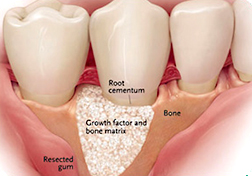Bone Grafting – In Preparation For Dental Implants


To begin with, it is important to understand that your jaw bone is what holds your teeth in place. The roots of your teeth are surrounded by bone which holds them firm. If you have a tooth extracted, you definitely need to replace it with something, such as a bridge, or, more and more often today, a dental implant, else, the remaining teeth are likely to “drift.”
Once a tooth is removed, the bone it came out of, over time, begins to slowly erode until a hollow or a basin shaped divot is created in the jaw bone. To prevent this from happening, your dentist should do a bone graft procedure. In this simple procedure, demineralized, sterile human bone granules (which look like course sand), are packed into the tooth socket immediately after the tooth is extracted.
The granules are then covered with a protective collagen membrane and a couple of stitches are used to close the tooth socket. This procedure is simple and usually does not add to your recovery time.

Over the next several weeks, your own bone will fill the tooth socket and preserve the bone height and width, which is necessary for any future restoration, such as a bridge.
If the extracted tooth is to be immediately replaced with a dental implant, the bone graft material should be tamped around the dental implant for optimum results. If the extracted tooth is not to be replaced immediately, then a bone graft to fill the empty socket (photo to the left) should be done.
If a dental implant is to be done immediately after extraction, then bone graft material should be tamped around the implant to fill the empty space (photo to the left).
When The Teeth Were Removed Years Before:

If the tooth, or teeth, were removed years ago, it is very probable that some bone loss has occurred which will hinder dental restoration. In such cases, a slightly more involved bone graft may be needed.
The gum will be opened with a small incision, the bone surface prepared, and then demineralized bone granules will be used to build the area up again.
The graft will be covered and protected with a special membrane, after which the gum will be closed tight with stiches. Over the next several months the bone graft will heal and integrate with the surrounding bone. The height and width of the bone will then be sufficient for completion of dental restoration.

In the not so distant past, dental implants for patients without sufficient bone width and height were not possible. But the new art and science of bone grafting and implant dentistry has made it possible for almost anyone to have replacement teeth that look just like natural teeth.
The modern art and science of dental bone grafting and dental implants make the ‘before’ and ‘after’ (photo to the right) results possible.
Call Arlington Dental Center at 904-743-3114 to make an appointment with Dr. Tim Bradberry to have your dental implants done.

